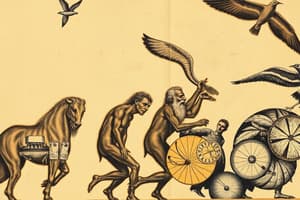Podcast
Questions and Answers
What is the theory of evolution?
What is the theory of evolution?
The theory of evolution explains that species living today are descendants of species from long ago.
How did Charles Darwin describe evolution?
How did Charles Darwin describe evolution?
Charles Darwin described evolution as descent with modification.
How does evolution occur?
How does evolution occur?
Evolution occurs on a large scale over a very long time.
How are you a descendant of your parents?
How are you a descendant of your parents?
What is a scientific theory?
What is a scientific theory?
Why is evolution considered a scientific theory?
Why is evolution considered a scientific theory?
What is the field of paleontology?
What is the field of paleontology?
How does the fossil record support evolution?
How does the fossil record support evolution?
What does radiometric dating help determine?
What does radiometric dating help determine?
Why is the fossil record important to the support and understanding of evolution?
Why is the fossil record important to the support and understanding of evolution?
What is one piece of evidence that supports the idea that whales and dolphins evolved from four-legged land animals?
What is one piece of evidence that supports the idea that whales and dolphins evolved from four-legged land animals?
What is biogeography and how does it support the theory of evolution?
What is biogeography and how does it support the theory of evolution?
What is homology and how does it provide evidence for evolution?
What is homology and how does it provide evidence for evolution?
How does embryology provide evidence for evolution?
How does embryology provide evidence for evolution?
What is molecular biology and how does it provide evidence for evolution?
What is molecular biology and how does it provide evidence for evolution?
Why is molecular biology particularly useful for studying the relationship between distantly related organisms?
Why is molecular biology particularly useful for studying the relationship between distantly related organisms?
What does the study of biogeography suggest about the distribution of species?
What does the study of biogeography suggest about the distribution of species?
What did Charles Darwin observe on the Galapagos Islands that led him to propose the theory of evolution?
What did Charles Darwin observe on the Galapagos Islands that led him to propose the theory of evolution?
What are homologous structures and how do they support the theory of evolution?
What are homologous structures and how do they support the theory of evolution?
How does the study of embryology provide evidence for evolution?
How does the study of embryology provide evidence for evolution?
Flashcards are hidden until you start studying




